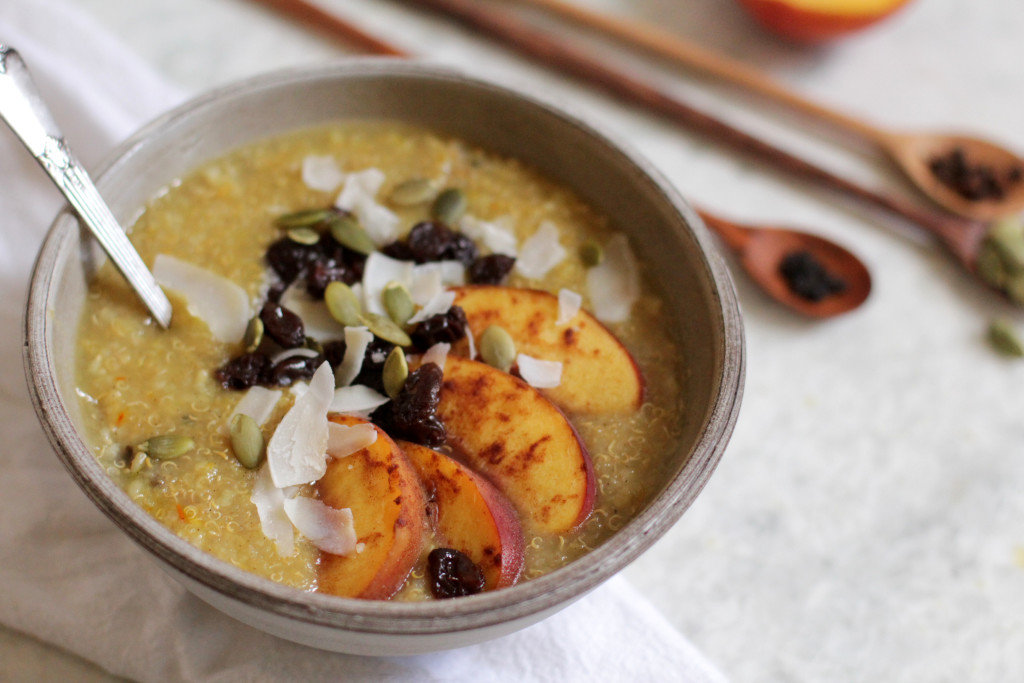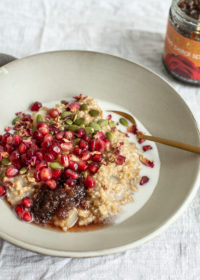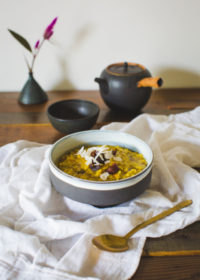Recipes: Ayurvedic Breakfast Porridge with Stewed Fruit
 In Ayurveda, it is said that it is more important how you eat, rather than exactly what you eat. A meal prepared in a loving, peaceful way contains more prana than one that has been prepared in anger or discord. Equally, a meal shared in gratitude has a sattvic effect on the body and mind. Taking from the old adage “you are what you eat”, wouldn’t you want to eat a meal that promotes inner peace and harmony? Maya Tiwari says that the two most important ingredients in a meal are love and kindness. Here are a few simple steps to elevating your kitchen experience.
In Ayurveda, it is said that it is more important how you eat, rather than exactly what you eat. A meal prepared in a loving, peaceful way contains more prana than one that has been prepared in anger or discord. Equally, a meal shared in gratitude has a sattvic effect on the body and mind. Taking from the old adage “you are what you eat”, wouldn’t you want to eat a meal that promotes inner peace and harmony? Maya Tiwari says that the two most important ingredients in a meal are love and kindness. Here are a few simple steps to elevating your kitchen experience.
Your kitchen should be a sacred, joyful space! Eliminate any clutter or distractions. Turn off the tv, take out the trash, and wash the dirty dishes – a clean kitchen means a clear mind as you begin to prepare your mindful meal.
Craft a loving intention to guide you in the kitchen. If negative emotions are present while cooking, the food will be affected. Watch how you’ll burn a dish when you are feeling angry (too much pitta!). Use your sankalpa as a prayer to infuse into your food while cooking.
Before you handle the food, take 5 deep breaths to ground and center yourself. Conscious breathing helps align you in the present as you begin to cook.
Cooking is a sensory experience. Awaken all five senses in the process. Take pause to notice how an onion in feels in your hand before you cut it, the sounds of the oil popping in a hot pan, what the herbs smell like as you slowly sauté them in ghee, and how the colors merge together in the pot to create the perfect sweet and savory stuffing that satisfies every taste bud.
From chopping the herbs, to stirring the pot, to the washing the dishes in between, merge completely and presently with each task at hand. This is true yoga. Should negative emotions arise, leave the kitchen and take a pause from your preparation. Allow the emotions to dissolve before returning with ease and attitude of love. Use your sankalpa as a tool for practicing contentment and connection in each moment.
As you sit down to serve and enjoy your food, take a moment to give gratitude for all those who’ve had a hand in your meal. Honor the farmer, the truck driver, the grocery store stocker, and all those in between the farm and your table. And at the end of your meal, remember to thank your body for receiving the nourishment you’ve prepared, for gratitude inward and outward is truly the best medicine.
5-6 cups water
3/4 cup dried quinoa
3/4 cup dried brown rice
1 tbsp ghee
1 cinnamon stick
1 tsp ground cardamom
5-6 whole cloves
5-6 threads saffron
pinch pink salt
In a medium saucepan, bring the water to a boil. Add the grains and spices, cover with a lid and simmer on medium heat for 30-40 minutes. Stir occasionally and continue adding water as needed until a soupy well-cooked consistency is reached. This can also be made in a slow cooker or rice cooker the night before for an easy, ready to eat morning porridge. Serve with stewed fruit and toppings of your choice (a splash of almond milk, shredded coconut, pumpkin seeds…just to name a few!).
Stewed Fruit
½ cup water
1 apple, apple or pear, cored/pitted & sliced
¼ cup raisins
2 dates, pitted & chopped
½ tsp cinnamon
In a small skillet, bring water to boil. Arrange the sliced fruit in one layer around the pan. Sprinkle the cinnamon, raisins and dates over top. Allow to simmer in the water until tender, about 3-5 minutes, adding more water to avoid burning or sticking to the pan. When ready, serve hot over top cooked porridge.
Makes 4 hearty servings
This recipe was created for Thoughtfully Magazine’s Fall/Winter Issue – grab a copy to get the recipe and more thoughtful living stories print!
 [wpmenucart]
[wpmenucart]





Beautiful post Claire, thanks for sharing it 🙂 xx
Thank you for the sweet words! So glad you enjoyed the post + practice.
I love the Ayurvedic take on eating. Eating mindfully is always something I’ve struggled with, but I’ve found that I am much more aware of my satiety when doing so. I guess that’s why they call it a “practice”, right? 🙂
[…] How you eat VS what you eat and a beautiful porridge recipe. […]
Can I ask why you add honey to the stewed fruit? In my Ayurvedic studies, I have learned that honey cooked or added to hot foods creates Ama in the body,
You are correct! Honey is best added at the end of the cooking process rather than cooked into the recipe. I’ve made a note in the recipe here and appreciate your feedback. Another option would be to substitute for maple syrup or omit the sweetener all together as the fruit can be quite sweet naturally.
HELLO! I DON’T SEE THE HONEY IN THE RECIPE ANYMORE. DID IT GET REPLACED BY THE DATES OR SHOULD THERE BE A SWEETENER OF SOME SORT IN THE PORRIDGE RECIPE?
THANK YOU FOR A BEAUTIFUL BLOG POST:)
The dates are cooked into the stewed fruit and provides quite a bit of sweetness. If you’d like more sweetness, you can drizzle some raw honey or maple syrup over top the finished porridge when serving if you’d like a little extra sweetness – but this is just for your tastes as you desire! The stewed fruit on its own is quite sweet already, so you may try it without any added sweetener to start.
Hi, thank you for this post. Just clarifying, and obviously there will always be different views, however I’ve read on another site which focuses on Ayurvedic food prep that fruit should be eaten alone as it’s the fastest to be digested and if combine with other foods can lead to gas, bloating etc. I’d welcome your views.
~ Marylka
Yes, typically raw fruit should be consumed on its own. When cooking fruit and adding digestive spices to it to make a chutney or compote, it can be combined with a whole grain porridge like this. It’s always dependent on your digestive capacity though, so if you find adding a cooked fruit compote to your breakfast porridge upsets your stomach, it may be best to stick with keeping all fruit separate.